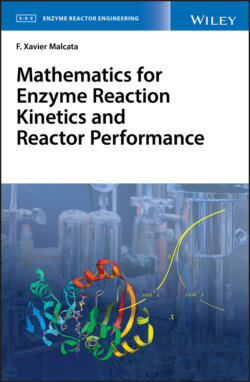Читать книгу Mathematics for Enzyme Reaction Kinetics and Reactor Performance - F. Xavier Malcata - Страница 35
2.4.2 Argument Transformation Formulae
ОглавлениеEquation (2.472), pertaining to sinh x, may be multiplied by Eq. (2.473), pertaining to cosh y, to get
(2.512)
– in much the same way said equations were combined to produce Eq. (2.497) when y = x; after applying the distributive property of multiplication, Eq. (2.512) becomes
(2.513)
or, after recalling the rule of multiplication of exponential functions conveyed by Eq. (2.15),
(2.514)
Algebraic rearrangement permits transformation of Eq. (2.514) to
(2.515)
which is the same as writing
(2.516)
in view of the functional form of Eq. (2.472). A similar rationale may be applied to the product of sinh y by cosh x to get
(2.517)
again based on Eqs. (2.472) and (2.473) – where the two factors may be pooled together as
(2.518)
Eq. (2.518) may also appear as
(2.519)
After splitting its right‐hand side and factoring out −1 in selected exponents, Eq. (2.519) becomes
(2.520)
so Eq. (2.472) may again be invoked to write
(2.521)
in view of Eq. (2.475), one may redo Eq. (2.521) as
(2.522)
Ordered addition of Eqs. (2.516) and (2.522) gives rise to
(2.523)
which simplifies to
(2.524)
following condensation of terms alike – while ordered subtraction unfolds
(2.525)
with combination of terms alike leading to
(2.526)
Note the similarity of Eqs. (2.524) and (2.526) to Eqs. (2.328) and (2.330), respectively.
If Eq. (2.472) is multiplied by itself – using x and y at a time as arguments, one gets
(2.527)
in which case the two fractions may be collapsed to produce
(2.528)
Eq. (2.528) may be rewritten as
(2.529)
with the aid of Eq. (2.15). After splitting the right‐hand side, Eq. (2.529) turns to
(2.530)
– which can be condensed to
(2.531)
at the expense of Eq. (2.473). Departure from Eq. (2.473) applied to x and y will instead lead to
(2.532)
where multiplication of the first by the second factor in the right‐hand side generates
(2.533)
after lumping exponential functions in the usual fashion, Eq. (2.533) transforms to
(2.534)
Algebraic reorganization of Eq. (2.534) gives rise to
(2.535)
which is equivalent to
(2.536)
due to Eq. (2.473). Ordered addition of Eq. (2.531) to Eq. (2.536) unfolds
(2.537)
that breaks down to
(2.538)
after condensation of similar terms; while ordered subtraction of Eq. (2.536) from Eq. (2.531) yields
(2.539)
– where negatives may be taken of both sides to get
(2.540)
Except for the change in sign, Eq. (2.538) matches Eq. (2.325), and Eq. (2.540) likewise matches Eq. (2.321).
Insertion of Eqs. (2.524) and (2.538) transforms Eq. (2.482) to
(2.541)
with division of both numerator and denominator by cosh x cosh y allowing simplification to (the more usual) form
(2.542)
again with the aid of Eq. (2.482); whereas divison of Eq. (2.526) by Eq. (2.540) supports
(2.543)
with division of both numerator and denominator by cosh x and cosh y justifying reformulation to
(2.544)
The similarity of Eqs. (2.542) and (2.544) to Eqs. (2.336) and (2.333), respectively, is again noteworthy – except for the change of sign in denominator.
A common form of Eq. (2.542) arises after setting y = x, viz.
(2.545)
– which breaks down to
(2.546)
A similar procedure, i.e. setting y = x, allows transformation of Eq. (2.538) to
(2.547)
or, equivalently,
(2.548)
elimination of sinh2 x via Eq. (2.496) unfolds
(2.549)
which leads to
(2.550)
after isolation of cosh2 x. Equation (2.550) is often preferable to Eq. (2.548), since it involves only hyperbolic cosines.
